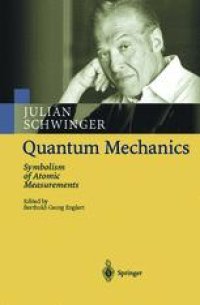
Ebook: Quantum Mechanics: Symbolism of Atomic Measurements
- Tags: Quantum Physics, Mathematical Methods in Physics, Atomic/Molecular Structure and Spectra
- Year: 2001
- Publisher: Springer-Verlag Berlin Heidelberg
- Edition: 1
- Language: English
- pdf
Julian Schwinger, who shared the 1965 Nobel Prize for physics with Richard Feynman and Sin-Itiro Tomonaga for his pioneering work on quantum electrodynamics, had a considerable influence on the conceptual development of modern quantum field theory.
In addition to being an extremely productive researcher he was also a brilliant teacher, and this book demonstrates his outstanding ability to expose a difficult subject in a clear and concise style. In marked contrast to many textbooks on quantum physics, the whole of quantum kinematics and the underlying quantum action principle, which now bears his name, are derived through a systematic analysis of experimental phenomena, thus avoiding the ad hoc postulates of the axiomatic approach. Many applications, all worked out in detail, follow and culminate in an introduction to quantum electrodynamics.
A unique legacy, these lecture notes of Schwingers course held at the University of California at Los Angeles were carefully edited by his former collaborator Berthold-Georg Englert and constitute both a self-contained textbook on quantum mechanics and an indispensable source of reference on this fundamental subject by one of the foremost thinkers of twentieth century physics.
Julian Schwinger, who shared the 1965 Nobel Prize for physics with Richard Feynman and Sin-Itiro Tomonaga for his pioneering work on quantum electrodynamics, had a considerable influence on the conceptual development of modern quantum field theory.
In addition to being an extremely productive researcher he was also a brilliant teacher, and this book demonstrates his outstanding ability to expose a difficult subject in a clear and concise style. In marked contrast to many textbooks on quantum physics, the whole of quantum kinematics and the underlying quantum action principle, which now bears his name, are derived through a systematic analysis of experimental phenomena, thus avoiding the ad hoc postulates of the axiomatic approach. Many applications, all worked out in detail, follow and culminate in an introduction to quantum electrodynamics.
A unique legacy, these lecture notes of Schwingers course held at the University of California at Los Angeles were carefully edited by his former collaborator Berthold-Georg Englert and constitute both a self-contained textbook on quantum mechanics and an indispensable source of reference on this fundamental subject by one of the foremost thinkers of twentieth century physics.
Julian Schwinger, who shared the 1965 Nobel Prize for physics with Richard Feynman and Sin-Itiro Tomonaga for his pioneering work on quantum electrodynamics, had a considerable influence on the conceptual development of modern quantum field theory.
In addition to being an extremely productive researcher he was also a brilliant teacher, and this book demonstrates his outstanding ability to expose a difficult subject in a clear and concise style. In marked contrast to many textbooks on quantum physics, the whole of quantum kinematics and the underlying quantum action principle, which now bears his name, are derived through a systematic analysis of experimental phenomena, thus avoiding the ad hoc postulates of the axiomatic approach. Many applications, all worked out in detail, follow and culminate in an introduction to quantum electrodynamics.
A unique legacy, these lecture notes of Schwingers course held at the University of California at Los Angeles were carefully edited by his former collaborator Berthold-Georg Englert and constitute both a self-contained textbook on quantum mechanics and an indispensable source of reference on this fundamental subject by one of the foremost thinkers of twentieth century physics.
Content:
Front Matter....Pages I-XIV
Prologue....Pages 1-25
Front Matter....Pages 27-27
Measurement Algebra....Pages 29-100
Continuous q, p Degree of Freedom....Pages 101-147
Angular Momentum....Pages 149-181
Galilean Invariance....Pages 183-192
Front Matter....Pages 193-193
Quantum Action Principle....Pages 195-221
Elementary Applications....Pages 223-267
Harmonic Oscillators....Pages 269-302
Hydrogenic Atoms....Pages 303-339
Front Matter....Pages 341-341
Two-Particle Coulomb Problem....Pages 343-374
Identical Particles....Pages 375-404
Many-Electron Atoms....Pages 405-435
Electromagnetic Radiation....Pages 437-471
Back Matter....Pages 473-484
Julian Schwinger, who shared the 1965 Nobel Prize for physics with Richard Feynman and Sin-Itiro Tomonaga for his pioneering work on quantum electrodynamics, had a considerable influence on the conceptual development of modern quantum field theory.
In addition to being an extremely productive researcher he was also a brilliant teacher, and this book demonstrates his outstanding ability to expose a difficult subject in a clear and concise style. In marked contrast to many textbooks on quantum physics, the whole of quantum kinematics and the underlying quantum action principle, which now bears his name, are derived through a systematic analysis of experimental phenomena, thus avoiding the ad hoc postulates of the axiomatic approach. Many applications, all worked out in detail, follow and culminate in an introduction to quantum electrodynamics.
A unique legacy, these lecture notes of Schwingers course held at the University of California at Los Angeles were carefully edited by his former collaborator Berthold-Georg Englert and constitute both a self-contained textbook on quantum mechanics and an indispensable source of reference on this fundamental subject by one of the foremost thinkers of twentieth century physics.
Content:
Front Matter....Pages I-XIV
Prologue....Pages 1-25
Front Matter....Pages 27-27
Measurement Algebra....Pages 29-100
Continuous q, p Degree of Freedom....Pages 101-147
Angular Momentum....Pages 149-181
Galilean Invariance....Pages 183-192
Front Matter....Pages 193-193
Quantum Action Principle....Pages 195-221
Elementary Applications....Pages 223-267
Harmonic Oscillators....Pages 269-302
Hydrogenic Atoms....Pages 303-339
Front Matter....Pages 341-341
Two-Particle Coulomb Problem....Pages 343-374
Identical Particles....Pages 375-404
Many-Electron Atoms....Pages 405-435
Electromagnetic Radiation....Pages 437-471
Back Matter....Pages 473-484
....